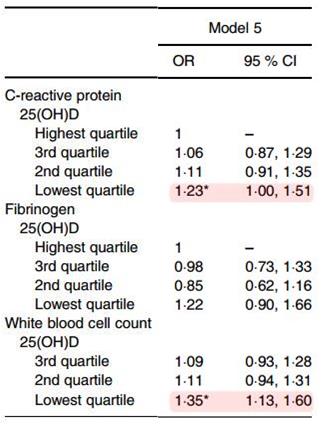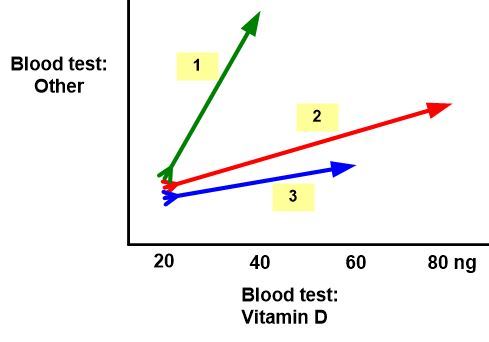Inflammatory blood markers (CRP, white blood cells) vary with Vitamin D level
Vitamin D and inflammatory markers: cross-sectional analyses using data from the English Longitudinal Study of Ageing (ELSA)
Journal of Nutritional Science (2017), vol. 6, e1, page 1 of 6 doi:10.1017/jns.2016.37
Cesar de Oliveira1 c.oliveira@ucl.ac.uk , Jane P. Biddulph1, Vasant Hirani2 and Ione Jayce Ceola Schneider3,4
1 Department of Epidemiology & Public Health, English Longitudinal Study of Ageing, University College London, London, UK
1Centre for Education and Research on Ageing, School of Public Health, ARC Centre of Excellence in Population Ageing Research, University of
Sydney, Sydney, New South Wales, Australia
3 Universidade Federal de Santa Catarina, Campus Ararangua, Santa Catarina, Brazil 4Department of Epidemiology & Public Health, University College London, London, UK
Recent evidence suggests that low vitamin D concentrations are associated with increased levels of inflammatory markers. However, there are limited studies investigating associations between vitamin D levels and inflammatory markers in the general population and much of this evidence in older adults is inconclusive. Therefore, this study investigates the cross-sectional association of serum 25-hydroxyvitamin D (25(OH)D) levels with inflammatory markers in 5870 older English adults from wave 6 (2012—2013) of the English Longitudinal Study of Ageing (ELSA). ELSA is a large prospective observational study of community-dwelling people aged 50 years and over in England. Serum 25(OH)D levels, C-reactive protein (CRP) levels, plasma fibrinogen levels, white blood cell count (WBC), age, season of blood collection, waist circumference, total non-pension household wealth, measures of health and health behaviours that included depression, number of cardiovascular, non-cardiovascular conditions and difficulties in activities of daily living, smoking, and physical activity were measured. There was a significant negative association between low 25(OH)D levels (<30 nmol/l) and CRP (OR 1-23, 95 % CI 1-00, 1-51) and WBC (OR 1-35, 95 % CI 1-13, 1-60) that remained after adjustment for a wide range of covariates of clinical significance. However, for fibrinogen, the association did not remain significant when waist circumference was entered in the final model. Our findings showed that 25(OH) D levels were associated with two out the three inflammatory markers investigated. The independent and inverse association between serum 25(OH)D levels and inflammation suggests a potential anti-inflammatory role for vitamin D in older English individuals from the general population.
Fully compensated model (5)

📄 Download the PDF from VitaminDWiki
See also VitaminDWiki
At birth, lower levels of vitamin D associated with higher levels of inflammation – Jan 2017
High maternal vitamin D resulted in 12 percent less inflammation (CRP) 20 years later – Oct 2016
Inflammation reduced by a single dose of Vitamin D (200,000 IU) – RCT Jan 2016
Inflammation (CRP) 3X higher in Winter-Spring neonates with low vitamin D – Nov 2015
4000 IU RCT reduces type 2 diabetes HOMA by 24% and CRP by 64% April 2010
Articles in both categories: Inflammation and Cardiovascular
{category}
 | | | | |
| --- | --- | --- | --- |
| Individual | Other
| | | | |
| --- | --- | --- | --- |
| Individual | OtherTest | Response to
Vitamin D | Hidden genes | | 1) | GOOD | POOR | GOOD hidden genes | | 2) | POOR | GOOD | POOR hidden genes | | 3) | POOR | OK | POOR hidden genes |
